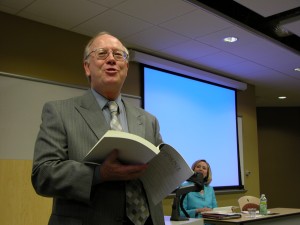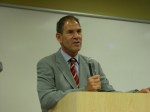[This story contains corrected copy, identified below.]
The Phoenix School of Law was the venue for an important event last evening. Amidst a panel of distinguished speakers, the school celebrated the launch of the newest volume of its Law Review.
What? Not enthralled yet? Well, pay attention.
The new volume is called the “Arizona Government Issue.” It includes “A History of the Arizona Courts,” written by the Arizona Chief Justice herself, Rebecca White Berch. So right there, it’s worth the price of admission.
Her excellent article is surrounded by eight others, only some of which I have begun reading. And that is because I just got a copy last night. In fact, the volume wasn’t even printed until the day before the launch symposium. Now that’s called hitting a deadline!
A law review, as they say, takes a village. But everyone present last night took the time to praise 3L Anthony Tsontakis. It was his idea more than a year ago to publish a volume coincided with the centennial of the Arizona Constitution.
Tsontakis describes himself as “a history kind of guy,” and he says his interest in government and elections grew through clerkships and internships at the Secretary of State’s Office (working with Joe Kanefield (an editorial board member of Arizona Attorney Magazine), at the Arizona Legislature and at the Goldwater Institute. (And another shout out to board member Keith Swisher, an assistant professor at the school and the volume’s faculty advisor.)
Anthony Tsontakis says that he contacted 50 to 70 people about possible articles, and then saw them through to publication. Preparations this week required “three consecutive all-nighters” and “53 straight hours” of work (Attention, legal employers! Hard worker on deck).
Tsontakis says that he hopes “the volume will demonstrate that today there are three bona fide law schools in the State of Arizona.”
The work—in the volume and in the launch symposium—paid off. (In fact, when I toiled away on law review as managing editor of the Hastings Comm/Ent, we never had lobster ravioli. All rise for the great catering!)
The evening began with PhxLaw Interim Dean Gene Clark talking about “the magic of the success of this book.” He then introduced Nick Dranias, an attorney with the Goldwater Institute.
[The following three paragraphs contain corrected copy.]
Dranias is one of the volume’s authors. He wrote “The Local Liberty Charter: Restoring Grassroots Liberty to Restrain Cities Gone Wild.” He wins for most evocative title, and for getting things off to a rousing start. In his remarks, he said that the Arizona Legislature “is designed to do one thing well: gridlock and stasis. Well done!”
Of course, Dranias was being complimentary, for he appreciates a body designed to “throttle back public passions.” Any body that fosters caution—“looking before you leap”—in terms of legislation is close to the heart of the Institute.
Dranias was humorous and ironic when he clarified, “As much as we would like to put the pedal to the metal and have the legislative process generate a conservative libertarian utopia, it tends to generate gridlock instead, and by design. But we must yield to temporary evils to secure the benefits of a written constitution.” (his corrected eloquent words, not mine).
Vice Chief Justice Andy Hurwitz was up next, and he spoke from his experience in all three branches of government. He admitted that “I learn something new every time I read our Constitution.” And so did we.
In his wide-ranging remarks, he talked about the constitutional provisions that involve judges, and the history of the State Bar sending names to the Governor for final selection.
He recalled that, when he was Chief of Staff to Gov. Bruce Babbitt, the then-conservative State Bar would send one name only for each opening. But Babbitt wasn’t going to be fenced in, and the Bar later would agree to send more.
Justice Hurwitz also remembered a time when electing judges was the norm—and not always such a good one.
As a young lawyer at the firm later named Osborn Maledon, Hurwitz arrived at court one day on a matter—only to find his opposing counsel already engaged in conversation with the judge.
“Drawing myself up to my full height, I said, ‘Your honor, this is highly improper.’”
But, he laughed, the judge simply replied, “Sit down, sonny. We’re not talking about your case. He’s also my campaign manager—we’re talking about my election.”
The Vice Chief Justice declined to say how the matter turned out.
Finally, Christy Smith spoke. She is Deputy General Counsel to Gov. Jan Brewer, and she encouraged law students in attendance to consider a life in public service. In fact, she believes that there should be more lawyers serving in the Legislature (no word on whether the Governor shares that view).
All in all, a momentous evening to honor a great accomplishment. Congratulations, and well done.
Read more about the Law Review of the Phoenix School of Law.






April 28, 2010 at 4:34 pm
Thank you for taking time to do the story. I teach Arizona Constitution and agree wholeheartedly with Justice Hurwitz that we need MORE legal scholars on the topic given our state is still in its youth (not quite 100 years yet since entering statehood).
Kudos to you Mr. Reporter.
April 29, 2010 at 9:12 am
Thanks for the coverage Tim! But just to clarify, I was talking exclusively about the legislative branch, not the Arizona constitution as such. The comment about gridlock applied to the legislative branch, which serves to throttle back public passions. Also, the utopia comment was meant ironically and I actually said something more like, “as much as we would like to put the pedal to the metal and have the legislative process generate a conservative libertarian utopia, it tends to generate gridlock instead and by design. But we must yield to temporary evils to secure the benefits of a written constitution.” Its pretty important that our ideas not be pigeonholed as impractical, so I hope you understand why this clarification was necessary. Thanks again for the coverage!
April 29, 2010 at 9:35 am
Thank you, Nick. I’ve made a correction (which is easier in blogs than in print!), and posted your comment. Thanks again.